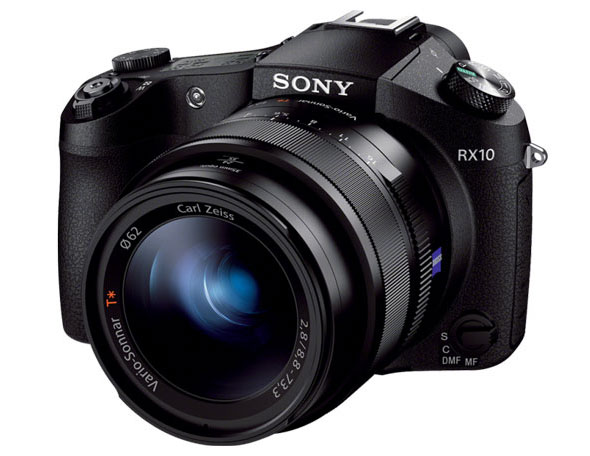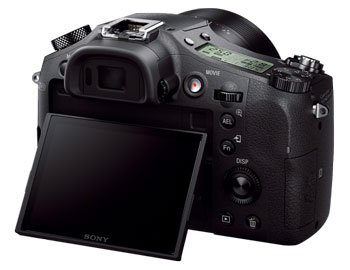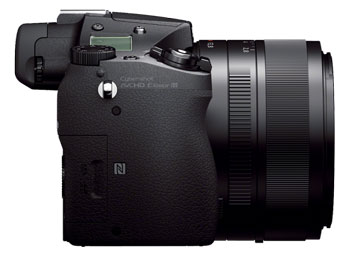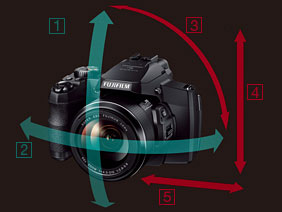Took the new Sony RX10 for a spin recently. Am still waiting for a reviewing model, so no sample images to post yet. But using and handling the RX10 was such a pleasant surprise that I’m seriously considering buying one myself. Was actually in the market for a pocketable RX100 II — right, albeit being two completely different beasts, these two cameras share the same 1-inch backlit 20.2MP Exmor CMOS sensor. But after handling the nicely built RX10 with its amazing zoom range (up to 400mm digital zoom), the RX100 II feels like a gimmick. It’s not only about getting what you pay for — at $1,298 the RX10 with its fixed bright Zeiss 24-200mm F2.8 Vario Sonnar T* costs about twice as much. It’s about having a whole system in a single camera, something the just updated Fujifilm X-S1 offers in a similar, cheaper and considerably less sexy package: the Fujifilm S1 with 50x optical and 100x digital zoom (24-2,400mm!) and Fujifilm’s fist 5-axis (3-stop) image stabilization.
Both the Sony and Fujifilm are bridge cameras. And yes, I try to avoid zooms. Am a generic wide angle guy, preferably 28mm. But these all-in-one superzoom bridge cameras, coupled with nice sensors and image stabilization, make using a zoom the most natural thing.

As so often recently, Sony dares to push the boundaries quite a bit more. While the RX10 is in no way a perfect camera, neither is any photographer. But this optically stabilized, Zeissed up RX renders such smooth, contrasty photographs with great depth of field or buttery bokeh, because Sony has come up with a camera design that’s an ideal compromise between sensor size, lens size and maximum aperture.
Want a bigger sensor? Live with a slower or much bigger lens…
In fact, the The RX10 is not a small and light camera, but whereas I’m struggling with the RX100’s gimmicky size the RX10 feels most natural. Considering the fast lens and stellar metal build quality with dust and weather seals, you get a powerful, easy to use all-in-one performer that’s still more compact than a compact system camera or DSLR with comparable lenses.
Says The Camera Store‘s Chris Niccolls:
Photographer and blogger Ming Thein goes as far as to say that, in all honesty, it’s probably the most “sufficient” camera out there:

It is far more capable in every way than most people will ever need; to be honest, I could get away with using one of these for almost all of my professional work (…) If I’m using this, what is all the other gear doing?
The RX10 offers all the buttons and controls one needs, and on top of it has all the bells and whistles you’d want in a serious video camera with built-in stereo microphone, uncompressed HDMI output, zebra stripes, clickless aperture, focus peaking, fine-grained manual levels control, external microphone and headphone connectivity, manual focus or autofocus, 24p cinema mode and last but not least manual exposure control, and well you’ve got one heck of a video camera.
For a still photographer, the RX10 certainly neither breaks your back nor bank. Consider a DSLR equivalent boasting a 200mm zoom range — with the digital zoom offering still usable 400mm. For less than $1,300 in a magnesium alloy package (including lens) that’s built to last.

Think the heretical: chances are you might even get the best-possible shots without interchangeable lenses… You won’t get the world’s speediest autofocus system, but a fast and reliable one with absolutely usable high ISO, smooth aperture ring, a premium build quality, excellent macro capabilities, no need to miss with other lenses and image stabilization that guarantees stable, steady video shoots.
Talking RX10, we also have to mention Fujifilm’s equivalent, the X-S1 for a third of the price. It goes without saying that the Sony blows other superzooms out of the water — the Fujifilm has half the pixels and a considerably slower Fujinon lens. But the Fujifilm has a 25% faster maximum shutter speed, optical viewfinder (for those who still care) and a 424mm longer maximum focal length (that can be digitally extended to a whopping 1,248mm…).

+++ You can order the Sony RX 10 from Amazon, B&H and Adorama for $1,298 (check out Adorama’s kits).
The new Fujifilm S1, world’s first weather resistant superzoom with articulating 3.0-inch LCD, is available from Amazon for $499.
The Fujifilm X-S1 can still be ordered from Amazon and eBay for a mere $349 upwards.


